10 Films Every Filmmaker Should Watch… differently
Do you react like this when someone suggests you watch Citizen Kane? >>
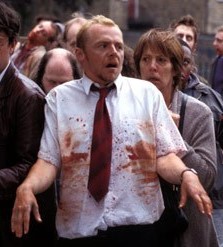
Well, then you’re watching it wrong.
“But if a film is NOT entertaining me then it must suck!!” you protest. “I tried watching Citizen Kane but it was a struggle…”
You fell asleep, didn’t you?
“Of course not! … maybe a bit.”
If you love film, and you want a career in film, you need to make an effort. Well, you may just need to start watching films differently. You also need to stretch your film knowledge back past Shaun of the Dead. Seriously.
So you think you need to educate yourself as a film-maker and a film-watcher, but you don’t know where to start…
Well, then, let me be your guide…
Any list is pretty arbitrary, when there is so much to choose from. Any list will be more about the personality of the list-maker than it is about creating some kind of indisputable top 10 of all films ever made.
And, like I say, try watching these films in a different way. Watch them at least twice. And the second time try to see how things work.
It’s like opening a cuckoo clock to find out how the mechanism operates, taking it apart and putting it back together again. Don’t just passively watch these films, investigate them.
I recommend this to any film-lover. If you want a deeper experience with a film – a longer-lasting relationship, so to speak – then you need to offer more from yourself, in the way of time and thought and love.
Does that sound weird? Well, you do claim to be a film lover, right?
Anyway, what?
Oh yes, a film list….
1. Citizen Kane (1941)
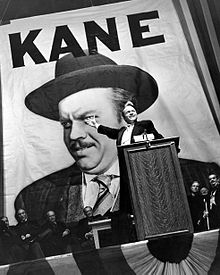 For decades, Citizen Kane was the number 1 favourite of film critics around the world.
For decades, Citizen Kane was the number 1 favourite of film critics around the world.
Citizen Kane is a 1941 American mystery drama film by Orson Welles, its producer, co-screenwriter, director and star. The picture was Welles’s first feature film. Nominated for Academy Awards in nine categories, it won an Academy Award for Best Writing (Original Screenplay) by Herman J. Mankiewicz and Welles.
It’s difficult to have an interest in the history of film and to have not heard about this giant legend of filmmaking. As person, he’s a fascinating character – he had a skill for self-publicity and self-aggrandisement, from an early age.
If you know anything about Welles, you might watch this film and wonder how much it is about the central character, Charles Foster Kane, a character based in part upon the American newspaper magnates William Randolph Hearst and Joseph Pulitzer. Or is it really about Orson Welles himself?
Why should you watch it? Well, it was a flop in the theatres. But then it blew filmmaker’s minds, through it’s re-invention and revolution of what a film could be.
The film is clever, complex, and Charles Foster Kane isn’t particularly likeable – which might put some people off. But if film is your intended trade, and film critics are still (even now) the gatekeepers to your destination, then might you not want to know why they adore this film so greatly?
You don’t need me to tell you why this film is so different to what came before. There’s a ton of stuff online for you to read and watch. And once you have watched the film, going to find out more about it is all part of the fun of loving films.
It’s quite incredible that Welles pulled this game-changing movie together at the age of 25, whilst playing the central character; a character who is portrayed by Welles throughout the character’s entire adult life, from young man to death in old age. And you can only imagine he did it through sheer force of personality.
Watch Orson Welles’ Citizen Kane on Amazon Prime
2. Vertigo (1958)
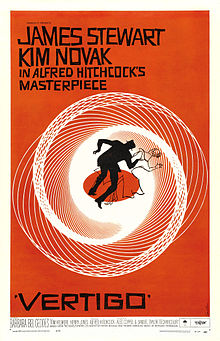 Since 2002, Vertigo has taken number 1 spot from the BFI’s critics top 100 list.
Since 2002, Vertigo has taken number 1 spot from the BFI’s critics top 100 list.
Many critics look back to the “golden age” of film, as if yearning for the return of a long lost love. Coincidentally, this is also the theme of their favourite movie – Hitchcock’s Vertigo.
Hitchcock was probably influenced by Welles’s films, but Welles would have been disgusted to see this film take precedence over Citizen Kane. During his later (bitter) years, Welles expressed a dislike for Hitchcock’s American films, saying of Vertigo, “I think he was senile a long time before he died.”
So why should you watch this film? On the surface, it’s a slow-paced thriller. The mystery feels a bit like a ghost story, for a while, but never goes too far in that direction.
Really, it’s about an obsessive man trying to bring back the past. Which is probably why so many film critics love it. Maybe they see themselves in this character.
That spiral on the poster (and in the film) is a great indication of the hypnotic, circular quality of the narrative. What does the poster suggest? Time travellers? Lovers trapped in time?
And trapping things in time is almost a definition of film itself. As filmmakers, are we being haunted by the ghosts of films past? Why can’t we let go? What happens if we do?
Anyway, you can’t be a film lover and not know about Hitchcock films. So get to it… Just set your mind to a different speed. Especially for the scenes where he follows Kim Novak around in his car.
By the way, this film influenced Chris Marker in the making of La Jetée (the clue is in the tree trunk), a film which was then re-made as Terry Gilliam’s Twelve Monkeys.
Watch Alfred Hitchcock’s Vertigo on Amazon Prime
3. The Passion of Joan of Arc (1928)
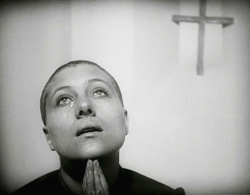 The Passion of Joan of Arc (La Passion de Jeanne d’Arc) is a 1928 silent French historical film based on the actual record of the trial of Joan of Arc.
The Passion of Joan of Arc (La Passion de Jeanne d’Arc) is a 1928 silent French historical film based on the actual record of the trial of Joan of Arc.
The film was written and directed by the legendary Danish director, Carl Theodor Dreyer. Joan is played by Renée Jeanne Falconetti, who gave her second and final performance on film – and, sadly, never understood why people applauded the acting in the film.
“For Falconetti, the performance was an ordeal. Legends from the set tell of Dreyer forcing her to kneel painfully on stone and then wipe all expression from her face – so that the viewer would read suppressed or inner pain. He filmed the same shots again and again, hoping that in the editing room he could find exactly the right nuance in her facial expression.” Roger Ebert.
Certainly, Falconetti’s performance is a powerful one, captured in painful close ups by Dreyer. Is the film – and the original story itself – some kind of fetishisation of female suffering?
After the film was cut down due to pressure from the Archbishop of Paris and from government censors, the original director’s cut was thought to be lost. Until one copy turned up in a Norwegian psychiatric hospital.
Watch Carl Dreyer’s La Passion de Jeanne d’Arc on Vimeo
4. L’Atalante (1934)
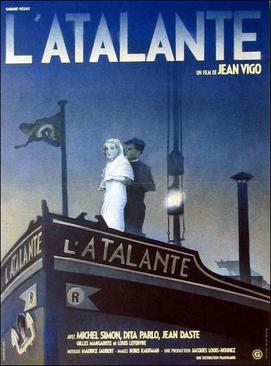 It’s always fun to stumble on a film and be surprised by it. I didn’t know what to expect when I ordered the DVD, about 15 years ago.
It’s always fun to stumble on a film and be surprised by it. I didn’t know what to expect when I ordered the DVD, about 15 years ago.
What I discovered was something fresh and alive. We’re used to films of this era being somewhat formal and premeditated. In contrast, this film manages to appear very spontaneous and instinctive.
The performances and the camerawork are intimate, simple and natural. And you can see why and how the films of Jean Vigo influenced the new wave of French cinema a couple decades later.
He didn’t get to make many films, as he died of tuberculosis at the age of 29, the year this film was released.
But the film itself feels like a work made with bare hands. A film which invites you in; to live with its characters for a couple of hours. One of those films where you feel interrupted when it ends, just as you were getting comfortable in your new life.
Then you’re forced to remember these people lived decades ago; that they’ve grown old and died, and never even knew you existed.
Watch Jean Vigo’s L’Atalante on Amazon prime
5. Duel (1971)
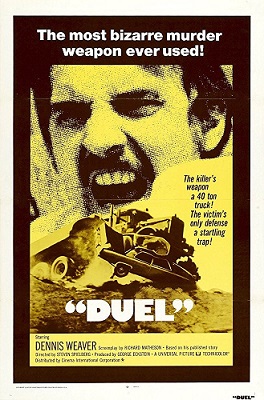 Duel is an American television thriller written by Richard Matheson (the guy who wrote the book I Am Legend), which is based on his own short story. The film is the full-length film directing debut of American director, producer, and screenwriter Steven Spielberg. The film later got a full theatrical release, after it turned out to be big hit with viewers.
Duel is an American television thriller written by Richard Matheson (the guy who wrote the book I Am Legend), which is based on his own short story. The film is the full-length film directing debut of American director, producer, and screenwriter Steven Spielberg. The film later got a full theatrical release, after it turned out to be big hit with viewers.
Just marvel at those first 5 minutes where Spielberg keeps you gripped to the screen, even though nothing happens except an ordinary guy drives his car along an empty highway.
Holy shit, how does he do that? Somehow, the shot selection and editing keeps you watching. You think you need to blow up half a city to get your audience’s attention? No you don’t, not if you have the skills.
Then marvel at the rest of the film, which is equally as gripping, even though the plot is absurdly simple: ordinary guy trying to get back home terrorised by an unseen truck driver.
Yes, it says “duel” and that’s what you get. A David vs Goliath vehicular combat to the death. And you can see how that led to his big breakout hit, Jaws – another battle between ordinary guy(s) and a Goliath-sized monster (shark).
Matheson’s script made explicit that the unnamed truck driver is unseen, aside from brief shots of his arms and boots. In the DVD documentary, Spielberg observes that fear of the unknown is perhaps the greatest fear of all… Later, in Jaws, the fact the automated shark didn’t work encouraged Spielberg to use that fear again – the less we see that shark, the more scary it is.
Actually, why not make a double-bill of it – Duel followed by Jaws.
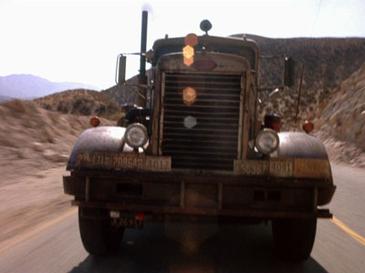
Watch Steven Spielberg’s Duel on YouTube
6. Being John Malkovich (1999)
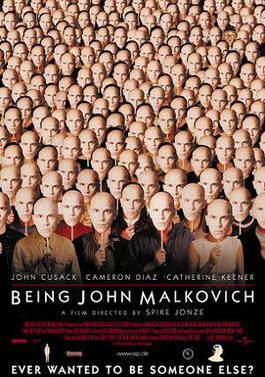 I guess, most of the time, these lists for filmmakers focus on the legendary visual auteurs of cinema history. How about some screenwriting mastery?
I guess, most of the time, these lists for filmmakers focus on the legendary visual auteurs of cinema history. How about some screenwriting mastery?
When I first saw this film I was sad and lamenting the lack of originality in 21st century cinema. Then… Being John Malkovich.
Yay.
I rejoiced. This film proved to me you could make something completely weird and original and people will go and watch it. And lo, I was rejuvenated.
So I say, watch this film for the bare-faced madness of the screenplay. Charlie Kaufman is one of those rare screenwriters whose scripts were (and are) so individual that you might think first about the writer of this film before the director (I had to look it up to be sure: Spike Jonze).
In this director-led industry, check out the screenplay pyrotechnics of the film which launched one of this century’s most well-known screenwriters (and later, director).
I may have mentioned this before, but I once had a game of chess with a guy who I knew I couldn’t beat if I played in a predictable way. So I went all out and just kept attacking, no matter what moves he made. For a while he was thrown… before he eventually won.
But I feel like Charlie Kaufman took the same approach with this screenplay – he just went all out to be creative and imaginative and followed his own whims as they took him. So, after 10 minutes in, you realise pretty much anything could happen in this story.
Plus, it gets you thinking. And you know how much I like films that get you thinking. I mean, it’s a film which is literally about seeing (and feeling) things from another person’s point of view. Which is really what stories are there for.
Probably.
Find Spike Jonze’s Being John Malkovich on Amazon
7. Le bonheur (1965)
 Le bonheur (“Happiness”) is a French drama film directed by Agnès Varda. Made in the year that I was born, but I didn’t see it until a few years ago. I watched knowing little about the director and basically nothing about the film.
Le bonheur (“Happiness”) is a French drama film directed by Agnès Varda. Made in the year that I was born, but I didn’t see it until a few years ago. I watched knowing little about the director and basically nothing about the film.
I include this film because it made me angry, the first time I watched it. Why? Because it betrayed my expectations for how people should act when someone they are in a loving relationship with falls in love with someone else.
I was sitting there waiting for the drama to kick off and it didn’t. “What terrible writing!” I fumed.
But then… about 30 minutes after the film finished… the genius of it dawned on me.
My anger had replaced the “missing” anger in the film. Interesting. Especially as I considered myself a seasoned film watcher and not so easily provoked.
So I recommend this film because it avoids the expected. And, unlike Being John Malkovich, it does so in such a subtle way, it might just get under your skin.
The film does throw up a number of unsettling questions as to the intention. But I’m not one to assume the director meant what we think she meant. Agnes will never tell you, so you’ll just have to keep pondering. Which is the whole point of art, isn’t it?
Le bonheur was Varda’s third feature film, made three years after Cléo from 5 to 7, and established her as a major French director – and the only woman allied to the powerful French new wave.
Find Agnès Varda’s Le Bonheur on Amazon
8. Barry Lyndon (1975)
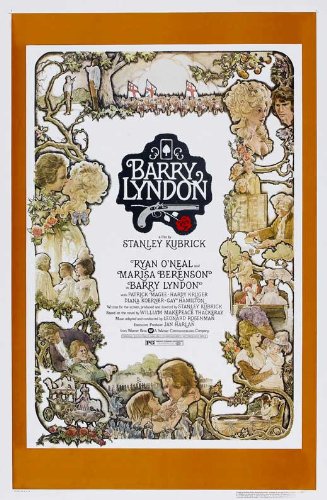 At a deliberately drawn out 187 minutes, Barry Lyndon is probably one of Stanley Kubrick’s least accessible films. And it was shot in 1975, from a book written in 1844.
At a deliberately drawn out 187 minutes, Barry Lyndon is probably one of Stanley Kubrick’s least accessible films. And it was shot in 1975, from a book written in 1844.
Kubrick was always experimenting and attempting things with film that wouldn’t even occur to others. In Barry Lyndon he chose to shoot the film without using electric lights. If there was not enough daylight, they used candles so it would look truly like the 19th century.
After some experimentation, they obtained three super-fast 50mm lenses (Carl Zeiss Planar 50mm f/0.7) developed by Zeiss for use by NASA in the Apollo moon landings, which Kubrick had discovered… must have been while he was faking the moon landings, right?
It’s really amazing the lengths conspirators will go to pull the wool over our eyes. I mean NASA got Zeiss to develop fast lenses to shoot stuff on the moon, even though they never intended to go there. Perhaps they did it for Kubrick, as part payment.
“Hey Stan, fake the moon landings and we’ll get some fast lenses made up for you to shoot your candle movie. Deal?”
Anyway, the thing which might put you off this film – it’s stately pacing – turns out to be its crowning beauty. Yes, the candlelit shots are stunning. But you really need to settle into the rhythm of the piece. Everything is shaped, including the dialogue and it’s delivery, to give the feeling of a formal 19th century dance.
The title music – Handel’s Sarabande from the Keyboard suite in D minor – is repeated relentlessly, punctuating the entire film. And the scene of the final duel is strangely electrifying, despite… well, actually, almost entirely because of the stretched out pacing.
Watch Stanley Kubrick’s Barry Lyndon on Amazon Prime
9. Faces (1968)
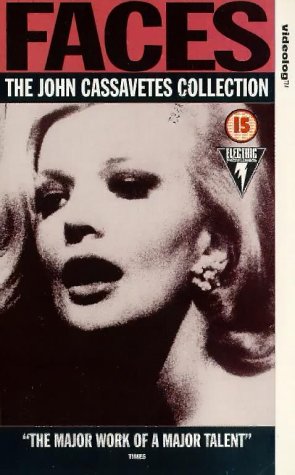 Better known as an actor, Faces was Cassavetes’ 2nd feature at the helm. Cassavetes was, to my mind at least, the grandfather of hip and cool indie film.
Better known as an actor, Faces was Cassavetes’ 2nd feature at the helm. Cassavetes was, to my mind at least, the grandfather of hip and cool indie film.
Cassavetes wasn’t a fan of modern American cinema – which he considered to be fake – and this was one of his attempts at breaking the mould. Faces, and his first feature, Shadows, were shot on tiny budgets, with cobbled together crews, and contained a raw energy which hadn’t really been seen in American cinema before.
These films were direct influences on Martin Scorsese’s Mean Streets and Taxi Driver and Woody Allen’s series of Manhattan-set philosophical romances.
These films really paved the way for the independent American cinema and the 1000s of hustled shoestring productions that have been scraped together in the decades since. Shadows was even part crowdfunded – when Cassavetes appealed for help on a local radio show, listeners started sending in $10s or $20s to get them started.
In fact, with Shadows coming out in 1959, that means we’ve had 60 years of American micro-budget filmmaking. Of course there were other films made this way before, but these 2 really had all the credentials. Shadows won the Critics Award at the Venice Film Festival. Meanwhile, for Faces actors Lynn Carlin and Seymour Cassel both received acting Academy Award nominations and Cassavetes was also nominated for the Best Original Screenplay.
Indie film was on the map.
“The greatest location in the world is the human face.” John Cassavetes.
Find John Cassavetes’ Faces on Amazon
10. Toy Story (1995)
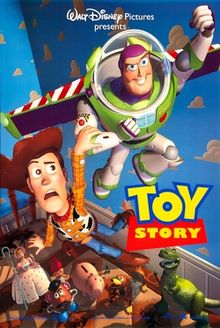 Toy Story is the first feature-length film to be entirely computer-animated, as well as the first feature film from Pixar. The virtual invention of a genre or the invention of a virtual genre? You decide.
Toy Story is the first feature-length film to be entirely computer-animated, as well as the first feature film from Pixar. The virtual invention of a genre or the invention of a virtual genre? You decide.
Anyway, it’s just a great story, isn’t it?
It’s certainly the biggest commercial success of any of the films in this list. On one level, the film is nothing but an 81 minute toy commercial. Possibly the greatest toy commercial ever made.
But the best thing for me is the character of Buzz Lightyear. If this had just been a story about a bunch of animated toys having adventures, it would’ve been just fine. But the Buzz Lightyear character shoots the story into outer space.
The idea that a toy thinks he’s an actual space ranger (and acts that way) gives the whole film an endearing existential twist. It’s like Blade Runner for 6 year olds. So there’s a toy with cognitive dissonance partnered with the feet-rooted-to-the-ground toy cowboy, Woody – who tries to bring Buzz to his senses… Isn’t this the plot to Don Quixote?
Anyway, it’s just a lot of fun. And at a pacey 81 minutes, you can watch it after Barry Lyndon as an antidote.
“To infinity and beyond!” Buzz Lightyear
That’s your 10. Of course there’s hundreds more you need to watch, too. This is just to get you started.
Ideally, you need to pick the big directors and then work your way through each and every single one of their films. And make sure to read up about all the behind the scenes stuff as you go.
Watch John Lasseter’s Toy Story on Amazon
Further reading: 10 best Films Funded by the Director
Eager to learn more?
Join our weekly newsletter featuring inspiring stories, no-budget filmmaking tips and comprehensive equipment reviews to help you turn your film projects into reality!
As an Amazon Associate I earn from qualifying purchases.
Simon Horrocks
Simon Horrocks is a screenwriter & filmmaker. His debut feature THIRD CONTACT was shot on a consumer camcorder and premiered at the BFI IMAX in 2013. His shot-on-smartphones sci-fi series SILENT EYE featured on Amazon Prime. He now runs a popular Patreon page which offers online courses for beginners, customised tips and more: www.patreon.com/SilentEye

